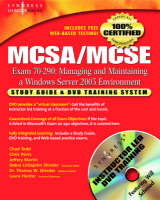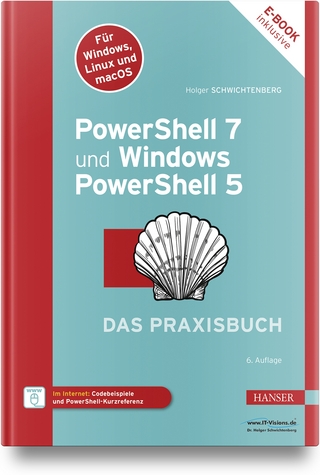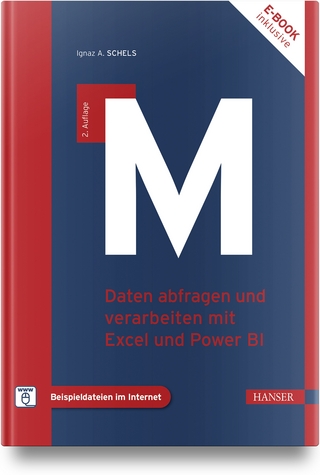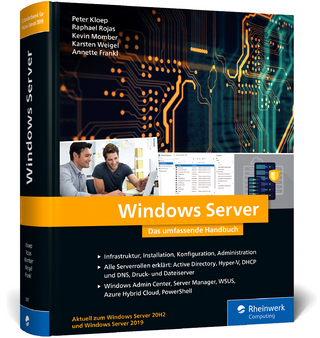
MCSA/MCSE Managing and Maintaining a Windows Server 2003 Environment (Exam 70-290)
Syngress Media,U.S. (Verlag)
978-1-932266-60-3 (ISBN)
- Keine Verlagsinformationen verfügbar
- Artikel merken
MCSA/MCSE Managing and Maintaining a Windows Server 2003 Environment: Exam 70-290 Study Guide and DVD Training System is a one-of-a-kind integration of text, DVD-quality instructor led training, and Web-based exam simulation and remediation. This system gives you 100% coverage of the official Microsoft 70-290 exam objectives plus test preparation software for the edge you need to pass the exam on your first try.
In June, 2003 Microsoft will launch beta exams for the Windows Server 2003 certification line. Exams will likely go live the following August and September. This launch is a comprehensive revamping of the MCSE (Microsoft Certified System Enginner) track with all new core exams and all new electives. In addition, the MCSA (Microsoft Certified System Administrator) certification will expand its program to include an additional upgrade exam for MCSAs wanting to become MCSEs.
The launch of this new certification track means that all current MCSEs, representing an installed base of approximately 200,000 (source: MCP Magazine) will need to recertify under Windows Server 2003. In addition, any MCP looking to become an MCSE--estimates are about 1.2 million (source: MCP Magazine)--will also have to continue their certifications under the new program.
Many industry experts expect the Windows 2003 certification, and product line as well, to be a more popular track since many organziations are still using NT and plan to skip 2000 and go directly to 2003.
Foreword
Chapter 1 Overview of Windows Server 2003
Introduction
History of the Windows Operating System Family
Out of MS-DOS: Where It All Began
Windows 9x versus Windows NT-Based Operating Systems
The NT OS Family Tree
Windows NT 3.x
Windows NT 4.0
Windows 2000
Windows XP/Windows Server 2003
Windows Server Operating System Basics
Client-Server Networking
The Domain Concept
Directory Services
What's New in Windows Server 2003?
Why a New Server Operating System?
New Features
The Windows Server 2003 Family
Why Four Different Editions?
Members of the Family
4.3 Manage Software Site Licensing
4.2 Manage Software Update Infrastructure
Summary of Exam Objectives
Exam Objectives Fast Track
Exam Objectives Frequently Asked Questions
Self Test
Self Test Quick Answer Key
1 Chapter 2 Managing Physical and Logical Disks
Introduction
Understanding Disk Terminology and Concepts
Microsoft Disk Terminology
Using Disk Management Tools
Using the Disk Management MMC
Using the Command-Line Utilities
1 Understanding and Managing Physical and Logical Disks
1.1 Manage Basic Disks
1.1 Managing Dynamic Disks
1.3 Optimize Server Disk Performance
1.3.2 Defragmenting Volumes and Partitions
Configuring and Monitoring Disk Quotas
1.3.1 Implementing RAID Solutions
Understanding and Using Remote Storage
Understanding Remote Storage Concepts
Setting Up Remote Storage
Troubleshooting Disks and Volumes
Troubleshooting Basic Disks
Troubleshooting Dynamic Volumes
Troubleshooting Fragmentation Problems
Troubleshooting Disk Quotas
Troubleshooting Remote Storage
Troubleshooting RAID
Summary of Exam Objectives
Exam Objectives Fast Track
Exam Objectives Frequently Asked Questions
Self Test
Self Test Quick Answer Key
Chapter 3 Configuring, Monitoring, and Troubleshooting Server Hardware
Introduction
Understanding Server Hardware Vulnerabilities
Understanding How Windows
1.4.1 Installing and Configuring Server Hardware Devices
1.4 Configuring Driver Signing Options
Using the New Hardware Wizard
1.4.3 Using Device Manager to Configure and Manage Devices
Device Installation and Configuration Best Practices
1.2 Monitoring Server Hardware
Using Device Manager
Using Event Viewer
Using Control Panel Applets
Using Command-Line Utilities
4.7.3 Using Performance Console
Hardware Monitoring Best Practices
Troubleshooting Hardware Devices
Diagnosing and Resolving Issues
Related to Hardware Settings
Diagnosing and Resolving Issues
Hardware Troubleshooting Best Practices
Summary of Exam Objectives
Exam Objectives Fast Track
Exam Objectives Frequently Asked Questions
Self Test
Self Test Quick Answer Key
2 Chapter 4 Managing User, Group, and Computer Accounts
Introduction
2.1 Understanding Security Objects
Understanding the Role of User Accounts
Understanding the Role of Group Accounts
Understanding the Role of Computer Accounts
Understanding the Role of Active Directory
Using Management Tools
Using the Active Directory Users and Computers (ADUC) Administrative Tool
Using Command-Line Utilities
2.4 Creating and Managing User Accounts
2.4.1 Using the ADUC MMC Snap-In to Create and Manage Users
Using the Command Line to Create and Manage Users
2.3.5/2.4.2 Automating User and Group Account Creation
2.4.3 Importing User Accounts
2.6 Troubleshooting User Accounts
2.3 Creating and Managing Group Accounts
2.3.1 Understanding Group Types and Scopes
2.3.3/2.3.4 Using the ADUC MMC
Using the Command Line to Create and Manage Groups
Group Management Tasks
Group Membership Management Best Practices
2.2 Creating and Managing Computer Accounts
2.5.1 Using the ADUC MMC Snap-In to
2.5 Using the Command Line to Create, Manage, and Troubleshoot Computers
Creating and Managing Domain Controllers
2.5 Troubleshooting Computer Accounts
Summary of Exam Objectives
Exam Objectives Fast Track
Exam Objectives Frequently Asked Questions
Self Test
Self Test Quick Answer Key
3 Chapter 5 Managing Access to Resources
Introduction
Understanding Access Control
Defining Access Control
3.1 Understanding and Using Access Permissions
3.3 Setting File-Level Permissions (NTFS Security)
3.1.2 Setting Shared-Folder Permissions
Shared Folders in Active Directory
3.3.1 Understanding How Permissions Are Inherited
Setting User Rights and Privileges
Understanding the Role of User Rights
2.7/3.4 Troubleshooting Access Problems
Identifying Common Access Problems
Basic Troubleshooting Guidelines
Using New Command-Line Utilities
Using where.exe
Using takeown.exe
Using EFS Encryption
Understanding Disk Encryption
Understanding How EFS Works "Under the Hood"
Encrypting Files and Folders Using the Graphical Interface
Using the cipher.exe
Applying EFS Best Practices
Implementing a Public Key Infrastructure
Understanding the Function of a PKI
Installing and Using the
Windows Server 2003 Certificate Services
Creating the Certificate Authority Hierarchy
Applying PKI Best Practices
Summary of Exam Objectives
Exam Objectives Fast Track
Exam Objectives Frequently Asked Questions
Self Test
Self Test Quick Answer Key
Chapter 6 Managing and Troubleshooting Terminal Services
Introduction
Understanding Windows Terminal Services
Terminal Services Terminology and Concepts
Terminal Services Components
4.4.2 Manage a Server by Using Terminal Services Remote Administration Mode
Using Remote Desktop for Administration
Using Remote Assistance
Downloading, Installing, and Configuring the Windows Messenger Tool for Use with Remote Assistance
Installing and Configuring the Terminal Server Role
Installing the Terminal Server Role
Using Terminal Services Client Tools
Installing and Using the Remote
Installing and Using the Remote Desktops MMC Snap-In
Installing and Using the Remote Desktop Web Connection Utility
Using Terminal Services Administrative Tools
3.2.2 Using the Terminal Services Manager
Using the Terminal Services Configuration Tool
User Account Extensions
3.2.2 Using Group Policies to Control Terminal Services Users
Using the Terminal Services Command-Line Tools
3.2 Troubleshooting Terminal Services
Not Automatically Logged On
"This Initial Program Cannot Be Started"
Clipboard Problems
License Problems
Summary of Exam Objectives
Exam Objectives Fast Track
Exam Objectives Frequently Asked Questions
Self Test
Self Test Quick Answer Key
Chapter 7 Using Server Management Tools
Introduction
4.4.3 Recognizing Types of Management Tools
Administrative Tools Menu
Custom MMC Snap-Ins
Command-Line Utilities
Wizards
Windows Resource Kit
The Run As Command
4.4 Managing Your Server Remotely
Remote Assistance
Using Web Interface for Remote Administration
Remote Desktop for Administration
Administration Tools Pack (adminpak.msi)
Windows Management Instrumentation (WMI)
Using Computer Management to Manage a Remote Computer
Which Tool To Use?
Using Emergency Management Services
4.7.2/4.5 Managing Printers and Print Queues
Using the Graphical Interface
Using New Command-Line Tools
The Printer Spooler Service
The Internet Printing Protocol
Managing and Troubleshooting Services
Service Configuration
Using the Graphical Interface
Using New Command-Line Utilities
Using Wizards to Configure and Manage Your Server
Using the Configure Your Server and Manage Your Server Wizards
Summary of Exam Objectives
Exam Objectives Fast Track
Exam Objectives Frequently Asked Questions
Self Test
Self Test Quick Answer Key
4.9 Chapter 8 Managing Web Servers with IIS 6.0
Introduction
Installing and Configuring IIS 6.0
Pre-Installation Checklist
Installation Methods
Installation Best Practices
What's New in IIS 6.0?
New Security Features
New Reliability Features
Health Detection
New Request Processing Architecture: HTTP.SYS Kernel Mode Driver
Other New Features
4.9.1 Managing IIS 6.0
Performing Common Management Tasks
4.9.2 Managing IIS Security
Troubleshooting IIS 6.0
Troubleshooting Content Errors
Troubleshooting Connection Errors
Troubleshooting Other Error
Using New IIS Command-Line Utilities
iisweb.vbs
iisvdir.vbs
iisftp.vbs
iisftpdr.vbs
iisback.vbs
iiscnfg.vbs
Summary of Exam Objectives
Exam Objectives Fast Track
Exam Objectives Frequently Asked Questions
Self Test
Self Test Quick Answer Key
Chapter 9 Monitoring Performance and Security
Introduction
4.6 Monitoring Performance
4.7 Using Task Manager to Monitor Performance
4.1 Using the Performance Utility to Monitor Performance
Using Command-Line Tools
4.8 Optimizing Servers for Application Performance
4.8.1 Monitoring Memory Objects
4.8.2 Monitoring Network Objects
4.8.3 Monitoring Process Objects
4.8.4 Monitoring Disk Objects
Auditing Security Events
Defining and Modifying Auditing Policies for Event Categories
Enabling Auditing of Object Access
Viewing the Security Log
Using Event Viewer
Event Types
Understanding Event Logs
Managing Event Logs
Troubleshooting Event Logs
Using Command-Line Tools
eventcreate.exe
eventquery.vbs
eventtriggers.exe
tracerpt.exe
Using the Shutdown Event Tracker
Shutdown Events Overview
Configuring the Shutdown Event Tracker
Working with the Shutdown Event Tracker
Using the Registry to Manage Shutdown Event Tracker
Defining Custom Shutdown Reasons
Summary of Exam Objectives
Exam Objectives Fast Track
Exam Objectives Frequently Asked Questions
Self Test
Self Test Quick Answer Key
Chapter 10 Planning and Implementing Disaster Recovery
Defining and Understanding Disaster Recovery
Understanding the Components of Disaster Recovery
Developing Business Continuity Plans
Developing the Disaster Recovery Plan
5.2 Creating a Backup Plan
Backup Concepts
5.1.3 Backup Media
Backing Up Data Files with the Backup Utility
Backing Up System State Data
5.1.4 Configuring Security for Backup Operations
5.4 Restoring Backed-Up Data
5.5 Scheduling Backup Jobs
Using the ntbackup Command-Line Utility
5.1 Creating a System Recovery Plan
Backing up System State Data
5.1.1 Creating an Automated System Recovery Set
Installing and Using the Recovery Console
Using Windows Startup Options
5.1.2 Working with Volume Shadow Copies
Making Shadow Copies of Shared Folders
Deploying the Client Software for Shadow Copies
Restoring Previous Versions of a File
Shadow Copies Best Practices
5.3 Recovering from Server Hardware Failure
The Role of Fault-Tolerant Disks
The Role of Server Clustering
Summary of Exam Objectives
Exam Objectives Fast Track
Exam Objectives Frequently Asked Question
Self Test
Self Test Quick Answer Key
Self Test Questions, Answers, and Explanations
Index
| Erscheint lt. Verlag | 9.12.2003 |
|---|---|
| Verlagsort | Rockland, MA |
| Sprache | englisch |
| Maße | 152 x 229 mm |
| Gewicht | 2010 g |
| Themenwelt | Informatik ► Betriebssysteme / Server ► Windows |
| Informatik ► Betriebssysteme / Server ► Windows Server | |
| Informatik ► Weitere Themen ► Hardware | |
| ISBN-10 | 1-932266-60-7 / 1932266607 |
| ISBN-13 | 978-1-932266-60-3 / 9781932266603 |
| Zustand | Neuware |
| Haben Sie eine Frage zum Produkt? |
aus dem Bereich


